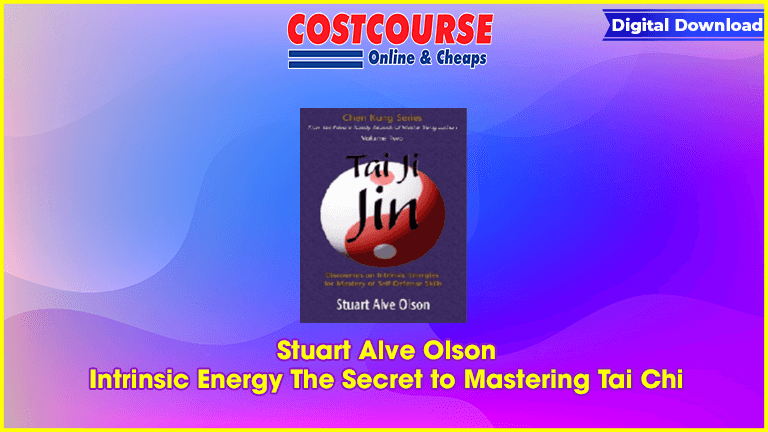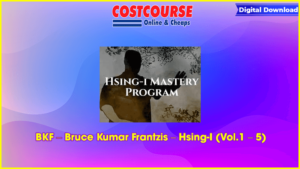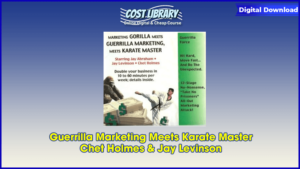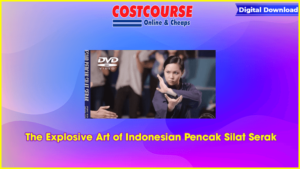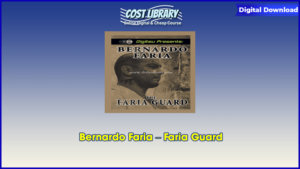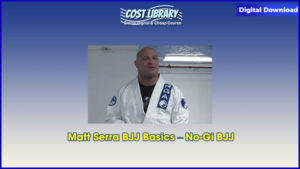Intrinsic Energy
The Secret to Mastering Tai Chi
Learn the art of staying in a state of deep relaxation yet alertness. Cultivating your Intrinsic Energy allows you to naturally respond to self-defense situations in the most effective way, neutralize any attack, and move through life with clarity, calm, and confidence.
Stuart Alve Olson – Intrinsic Energy The Secret to Mastering Tai Chi
Most of us, even those of us who’ve been learning and practicing Tai Chi for years, find ourselves losing our calm center and reacting with tension in a self-defense situation.
We may feel relaxed and experience our Qi flowing as we practice our solo form or practice two-person with a partner we’re used to, but the minute we’re in an unknown situation, or up against someone who intimidates us, we may overreact with too much aggression or fear, or freeze up inside and not know what to do.
When we lose control of ourselves, we lose control of the situation. That’s why Stuart Alve Olson calls Tai Chi, not self-defense but “defense against the self.â€
Our ways of dealing with self-defense situations tend to mirror the ways we deal with the everyday stressors of life. Most of us have a pattern we fall into when we feel threatened. Instead of responding effectively, we may react with too much forcefulness, anxiety, or by going into collapse.
Because we have these habits of reacting with tension in our body, even though we experience a calming of the mind while performing Tai Chi, we don’t achieve what the early masters called “Song,†which is a catlike state of sensitivity, alertness, and relaxation in the body.
This art of staying in a state of deep relaxation yet alertness allows you to develop your Intrinsic Energy. Using Intrinsic Energy in the application of Tai Chi allows you to neutralize an opponent with what appears to be a supernatural ability, and move through life with clarity, calm, and confidence.
We’re offering a live teaching series on Intrinsic Energy coming up on October 6th. If you know that you’re in, click the sign-up button below. If you’re not quite sure and would like a little more information, keep reading, we have more details on what you will find in this course below.
Most students of Tai Chi have heard stories about classic Tai Chi Masters doing incredible and inexplicable things because of the internal power they’ve cultivated.
These powers have seemed mythical and mysterious, and they have intrigued our imaginations, but there’s never been a clear path for how to attain this level of mastery.
As Stuart said, “When I was with Master T.T. Liang at age 32, I couldn’t believe how at age 82, he was so easily knocking me down. It took me a few years to realize what he was using. I always thought it was something mystical, that I had to get this thing called ‘Qi.’ We throw this Qi word around because it comes off as magical, but it’s really not. As Master Liang said, ‘No, it’s Intrinsic Energy that’s required to master Taijiquan.’
So I practiced these things, solo form, two-person, applications, and studying the old Chinese texts, and then one day he said, ’Ooh, you’ve got Intrinsic Energy.’ It took me 15 years to learn how to further develop these Intrinsic Energies because I didn‘t have this course. I’ve now created what I wish I’d had back then.â€
Stuart Alve Olson had a long tutelage with Master T.T. Liang, who himself studied with many foremost masters in Taiwan in the middle of the last century. Stuart lived and taught with Master Liang for many years, which exposed him to the inner teachings of Intrinsic Energy.
Along with his personal practice, Stuart has studied and translated many original writings on Taijiquan, and had the opportunity to learn from Master Liang how to interpret and apply these texts in his practice.
Stuart has written a book on Intrinsic Energy called Tai Chi Jin, which you can learn more about below, and find on Amazon if you’re interesting in reading more on this topic.
For the first time ever, Stuart is going to transmit his teachings on the 34 major types of intrinsic energy in an in-depth yet easy-to-understand way.
Along with transmitting this knowledge, he will teach the rare methods to develop each of these Intrinsic Energies.
This will go into more depth on each of the energies than the book was able to cover and share these training methods that were not in the book.
Intrinsic Energy is something that develops through a serious practice of Taijiquan, through the exercises of Sensing Hands (Tui Shou), Greater Rolling-Back (Da Lu), and Dispersing Hands (San Shou). But unless you have the right teacher, the right knowledge, and a systematic way to cultivate it, it’s very slow and difficult to actually develop Intrinsic Energy in a substantial way on your own.
With this program you can take advantage of Stuart’s years of study and practice and the insights he’s gained from teachers and from his own experience, to gain a faster, more reliable and effective route to developing your Intrinsic Energy and mastering Taijiquan.
This is the first and last time this course will ever be held live. If you’re ready to join us for this one-time opportunity to engage with Stuart on this topic and get all your questions answered, click on the button below. Or keep reading for more information on what will be covered in the course, so you can see if this program is a good fit for you.
Recommended Reading for the Course
This volume in the Chen Kung Series is a landmark translation and explanation of Taijiquan’s most profound text—the Yang family’s secret training journal on Intrinsic Energies (Jin). The commentary explicates a work that will be an essential reference for any Taijiquan practitioner.
Praise for Stuart’s book Tai Ji Jin: Discourses on Intrinsic Energies for Mastery of Self-Defense Skills
Master T.T. Liang
author of T’ai Chi Ch’uan for Health and Self-Defense
My student, Stuart, has unquestionably proven his salt. His translation of Chen Kung’s book is without doubt second to none on the subject of T’ai Chi Ch’uan.
Master Jou Tsung Hwa
author of The Tao of T’ai Chi Ch’uan
This book is a very good document for both T’ai Chi players and instructors. Nowadays, no one has completely reached the high levels described here. Therefore, this book really provides important goals to work toward attaining. If a dedicated T’ai Chi player can master these different “energies,†they will help promote the art to a very high level.
Terry Dunn
author of T’ai Chi for Health: The Yang Long Form
An excellent and extremely informative translation of an important body of work, that includes many principles and techniques not found in popular T’ai Chi manuals. Olson has written an accurate and lucid translation of a broad treatise, which, flavored by insights from his own experience of the oral teachings, renders an invaluable service in bridging the gap between theory and practice, enriching the understanding and practice of T’ai Chi players at all levels.
Get immediately download Stuart Alve Olson – Intrinsic Energy The Secret to Mastering Tai Chi
Program Syllabus
Join us for this three-month intensive online seminar series, held weekly on Wednesdays at 7:00 p.m. Central Time between October 6th and December 29th. There will be a talk and a Q&A component for each class session.
Recordings will be available afterwards, so those of you who can’t attend live can watch later on your schedule, and you will have lifetime access to the recordings.
October 6: Explanation of Intrinsic Energies / Jin vs Qi / The Training and Development of Jin
October 13: Adhering and Sticking Energies
October 20: Listening and Interpreting Energies
The first four intrinsic energies—Adhering, Sticking, Listening, and Interpreting—are the very foundation of learning all of the other Taijiquan intrinsic energy skills. Their importance can not be overlooked or diminished.
These intrinsic energies are all based on the idea and development of learning how to externally and internally sense not only the opponent’s action but your own reactions as well. As the Taijiquan Classic states, “To know yourself is to know your opponent.â€
Therefore, to know yourself you must develop a high degree of sensitivity and awareness. This is accomplished in Taijiquan by training the principles and skills of Adhering-Sticking, Listening, and Interpreting intrinsic energies.
Through Adhering skills you develop non-opposition to an opponent’s actions, and with Sticking skills, non-separation from an opponent’s movement. With Listening skills, you develop an awareness and inner sense of the opponent’s intentions. With Interpreting skills, you learn to react naturally and spontaneously to an opponent. All of these skills are essential fundamentals to all subsequent intrinsic energies, as the ideas of non-opposition, non-separation, awareness, and spontaneity are the very crux of Taijiquan in conjunction with self-defense.
October 27: Receiving, Neutralizing, and Enticing Energies
These three energies—Receiving, Neutralizing, and Enticing—are essential to Taijiquan’s self-defense skills. When your skill becomes high enough, it is easy to see how every technique and intrinsic energy skill is really functioned at their root by one of these three energies.
November 3: Seizing, Issuing, and Borrowing Energies
A defender using Taijiquan needs to apply these three energies to diffuse any attack properly and must do so as if making one action that is seeming without effort.
The development of these three energies is first trained, in part, with Sensing Hands practice, and then brought to their highest levels in Dispersing Hands and Greater Rolling-Back training. In their higher form, these energies develop into Receive-Attack, Neutralize-Attack, and Borrow-Attack techniques mentioned in the Taijiquan classical texts. Meaning, to receive an attack is to issue, and to neutralize an attack also means to issue. and Borrowing is also used for issuing—they are one action. But in the beginning stages of learning, the student must learn to see these energies as separate actions and ideas.
November 10: Opening and Closing Energies
November 17: Rising and Sinking Energies
The next four energies are contained and developed in absolutely every movement and technique within Taijiquan—from simple breathing exercises to the highest techniques. When you inhale, that is opening/rising. When you exhale, that is closing/sinking. When you neutralize an attack, that is opening/rising. When you issue, that is closing/sinking. Adhering is opening/rising; sticking is closing/sinking. When you adhere Qi to the spine, that is opening/rising. When you issue it off the spine, that is closing/sinking.
When training the martial aspects of Taijiquan it will become readily apparent that when you neutralize and entice an opponent’s incoming attack, that is using Opening energy. When you seize and attack, that is using Closing energy. Also, to neutralize means enticing an opponent’s energy (their movement, breath, and intention) upward. This is to apply Rising energy. With seizing and issuing, you bring the opponent’s energy downward—thus Sinking energy is used.
These energies are regarded as complementary for another reason as well, but it takes a long experience to really perceive and understand it correctly. For example, when you initially issue to an opponent, you are using Rising energy with the immediate intention of using Sinking energy. This is best related to the actions of the troughs and crests of waves—where each creates and is followed by the other. Also, think of the movement of a whip. All the energy is sent out to the tip of the whip, but in the instant of hearing the crack, the length of the whip is already limp. Wavelike motions best describe the actions of these four energies, and all are paramount to the proper functioning of Taijiquan.
November 24: Warding-Off, Rolling-Back, Pressing, and Pushing Energies
December 1: Pulling, Splitting, Elbowing, and Shouldering Energies
Eight Operations Energies:The common mistake of many Taijiquan adherents is to perceive these Eight Operations, or posture, energies as wholly just techniques—such as those seen in the solo form postures—but the practical applications vary in execution as they are based more on intention than on a specific method of movement. For example:
Warding-Off energy is any springing type of action, such as might be seen when pushing an air-filled ball below the water and then releasing it. The energy of the ball leaping out from the water is synonymous with Warding-Off energy.
Rolling-Back energy is any non-resistant or yielding action, such as seen with an incoming soccer ball and then either going out to absorb the energy (as a soccer goalie might perform) or sidestepping the force and sending the ball on its way as seen in Borrowing energy.
Pressing energy is defined as any reactionary or rebounding force, such as bouncing a ball or throwing a coin onto a drumhead.
Pushing energy is like the troughs and crests of waves or the filling of empty spaces—it is both overwhelming and pervasive. Like water, it appears soft, but hidden within is something very powerful. So being pushed by someone with Taijiquan skills is sometimes perceived as being hit by a large wave of water or being swept away in a current.
Pulling energy is seen clearly in the action of a lever. Pull on the right side and the left comes at you. Attack below and the upper will strike you. Like a balance beam, whichever side is weighted the other side reacts.
Splitting energy is like a whirlpool or a spinning object. If you enter into one of these you will either be dragged under or sent flying away.
Elbowing energy is seen in unbroken and connected energy, like the action of a whip. Even though an opponent might be struck by the elbow, the shoulder or fist will immediately follow—this is called the “folding-up†technique.
Shouldering energy is like the action of pounding a pestle in a mortar to crush something. To an opponent, shouldering energy feels like running blindly into a brick wall.
From these brief explanations, you can see that the energy of the Eight Operations is not purely a matter of using some technique but more of how they are expressed and function.
December 8: Long and Intercepting Energies
In Long energy, everything is soft and gradual, and can reach anywhere it chooses. Every part of the body becomes a weapon and can issue intrinsic energy. Like a metal spring extended out to its limit, its recoiling effects are devastating to an opponent.
Intercepting energy is hard and sudden, and can reach anywhere it chooses as well. Again, every part of the body becomes a weapon and can issue intrinsic energy. Like a person assuming something is solid and pushes on it, only to find it is no longer there, and then suffering the effects of falling hard.
December 15: Drilling and Lofty Tower Energies
Drilling energy relies on the use of natural torquing power. Everything in nature makes use of circular, arcing movements. So in mimicking nature, Drilling energy becomes the most effective of all martial energies. As in being shot by a gun, the point of entry is hardly noticeable, but the exit wound is ripped wide open. A Taijiquan master using Drilling energy may strike an opponent externally, but the real damage occurs internally.
High Lofty energy borders on what we would call the mystical, but it results from developing a strong spirit or mental concentration. Examples of this energy can be seen in a Taijiquan master’s ability to knock over an opponent with just the expelling of the sound “ha!†In the ability to wave a hand or point at a candle and extinguishing the flame. Or in the highest ability of Sticking energy, whereby objects are lifted without having to grasp them.
December 22: Restraining and Seizing Energies
Grasping Sinews and Tendons
Closing Qi Cavities
December 29th: Grasping and Closing Energies
Restraining Blood Arteries
Seizing Qi Meridians
It is said that mastering these four energies that will be covered in the last two classes makes a practitioner “unbeatable,†so they are without question the culmination and distillation of all the Taijiquan energies.

